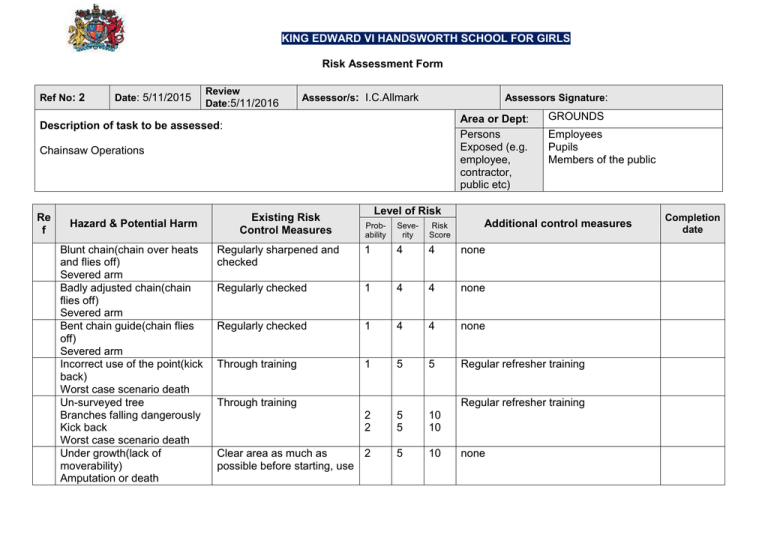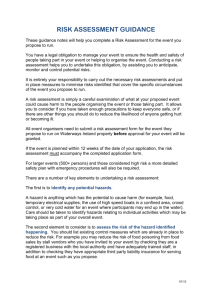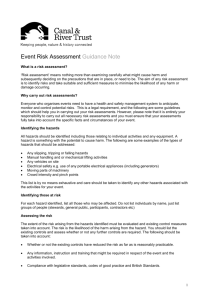Risk Assessment: How to Complete the Form
advertisement

KING EDWARD VI HANDSWORTH SCHOOL FOR GIRLS Risk Assessment Form Ref No: 2 Date: 5/11/2015 Review Date:5/11/2016 Assessor/s: I.C.Allmark Assessors Signature: Area or Dept: Persons Exposed (e.g. employee, contractor, public etc) Description of task to be assessed: Chainsaw Operations Re f Hazard & Potential Harm Blunt chain(chain over heats and flies off) Severed arm Badly adjusted chain(chain flies off) Severed arm Bent chain guide(chain flies off) Severed arm Incorrect use of the point(kick back) Worst case scenario death Un-surveyed tree Branches falling dangerously Kick back Worst case scenario death Under growth(lack of moverability) Amputation or death Existing Risk Control Measures GROUNDS Employees Pupils Members of the public Level of Risk Additional control measures Probability Severity Risk Score Regularly sharpened and checked 1 4 4 none Regularly checked 1 4 4 none Regularly checked 1 4 4 none Through training 1 5 5 Regular refresher training 2 2 5 5 10 10 Clear area as much as 2 possible before starting, use 5 10 Through training Regular refresher training none Completion date KING EDWARD VI HANDSWORTH SCHOOL FOR GIRLS Re f Hazard & Potential Harm Existing Risk Control Measures Level of Risk Additional control measures Probability Severity Risk Score 2 5 10 none 2 5 10 none 1 5 5 none 2 5 10 Through training refreshers 2 5 10 none 2 5 10 Refresher training correct PPE, operators should be sufficiently agile Trips and falls Amputation possibly death Uneven, slippy surfaces Amputation possibly death Unauthorised people in the danger area Serious injury to others Use of ladders and climbing frames Over-reaching when working on a ladder/climbing frame Falls, lack of control causing serious injury or death Reaching overhead with a chainsaw Check area as much as possible for trip hazards, take extra care Check that the chain brake is on if moving to the job, use correct PPE Take extra care when walking or moving on this type of surface, check the chain brake is on before moving on this type of surface, use correct PPE Stop working until they have been removed, area well signed and policed Only used as a last resort, by operators trained in the use of ladders and climbing frames, only certificated operators allowed to use, correct PPE Position ladders/climbing frame in a position where you eliminate the need to do so Use ladders/climbing frame Using correct climbing methods and ropes get Completion date KING EDWARD VI HANDSWORTH SCHOOL FOR GIRLS Re f Hazard & Potential Harm Existing Risk Control Measures Level of Risk Probability Severity Risk Score Additional control measures Lack of control, serious injury or death above the branch, climbing certificate required Manual handling Back injuries/crush injuries Full manual handling training 1 4 4 Refresher courses on manual handling Unqualified chainsaw operators ground/ or climbing Amputations/death Must be supervised at all times by a fully qualified person, not allowed to go up trees until they have a ground chainsaw licence Full training in the climbing license is given 2 4 8 Sent on a recognised chainsaw course as soon as possible 1 5 5 Refresher training course Misuse/not using ropes when needed Falls, trips/insecure cutting area which could lead to amputations or even death Completion date KING EDWARD VI HANDSWORTH SCHOOL FOR GIRLS Re f Hazard & Potential Harm Existing Risk Control Measures Level of Risk Probability Severity Risk Score Additional control measures Completion date Risk Assessment: How to Complete the Form You need to gather together all the relevant information on the risks and hazards of the task being assessed. You can use the risk-assessment form to help you make the assessment and create a written record of that assessment process. The first part of the form is used to record the date of assessment, review date, description of the task to be assessed, the department or area and who may be exposed to the hazards. Initial Risk Assessment In this section you need to consider what the hazards are. In doing this, it is important to consult with staff who work in the area and any existing documentation that may have a bearing on the risk assessment (e.g. documented procedures and policies, equipment used, services used (electricity, gas, etc) and maintenance procedures). Once the hazard has been identified you should then decide what the potential harm is from the hazard and what existing control measures are in place. An example is given in Table 1. Hazard Table 1 Using computer workstations incorrectly Lifting heavy files on to shelving Potential Harm Repetitive strain injury and back injury Injury, especially to the lower back Existing Risk Control Measures Induction training given None For each hazard the level of risk is estimated taking into account the existing control measures. So for the above two examples: Level of Risk Table 2 Likelihood Severity Risk Score Using computer workstations 4 3 12 Lifting heavy files 4 4 16 Section B – Additional Risk Control Measures For each hazard that you have assessed with a risk greater than 5 (i.e. a medium or high risk), you need to list it in section B. You then need to list, where practicable, any additional things that can be done to reduce the risk as shown in Table 3. Table 3 Hazard Using computer workstations incorrectly Lifting heavy files on to shelving Additional Control Measures 1. Carry out full DSE workstation assessment. 2. Ensure corrective actions implemented. 1. Use trolleys to transport files. 2. Use steps to gain access to shelves. 3. At risk staff to carry out manual handling training. With these new control measures in place the risk is re-assessed as shown in table 4. The person responsible for carrying out or implementing the additional control measures completes the last two columns in section B, which includes a target completion date. Page 5 of 9 Probability Severity Nil 1 Minor 2 7-day 3 Major 4 Fatal 5 Very likely 5 5 10 15 20 25 Probably 4 4 8 12 16 20 Possible 3 3 6 9 12 15 Remote 2 2 4 6 8 10 Improbable 1 1 2 3 4 5 Level of risk Action and timescale High You should not start work until the risk has been reduced. You may have to set aside considerable resources to reduce the risk. If the risk involves work in progress, you should take urgent action. If it is not possible to reduce the risk even with unlimited resources, you must stop all work. Medium You must try to reduce the risk, but should carefully measure the cost of prevention. You should use measures to reduce the risk within a defined time period. If the medium risk is associated with extremely harmful consequences, you may need to carry out another assessment to identify more precisely the likelihood of harm. This will help you decide whether you need to use improved control measures. Low You don’t need to take any further action or keep documentary records. Monitoring is necessary to make sure that the controls are still effective. Page 6 of 9 Risk Assessments Aide-Memoir The following headings will give you a number of most likely disciplines you should consider when undertaking a risk assessment. Decide if any of the main headings apply to the task and then add them onto the risk assessment form as a hazard. Some headings ask questions, e.g. Permits to Work section. You must consider whether these are required and if so which one. These will then be added into the remedial actions column. Consider also the bullet points attached to each section. They may provide you with some of the remedial actions that you need to take as well. Please Note: This is not intended to be an exhaustive list. Your particular tasks/area may have other considerations to be taken into account. Accident Procedures - Do you have the correct procedures in place? Is there an accident book (compliant with the Data Protection Act) readily available? Has everyone received training in the company’s accident procedure? Has someone been made responsible for RIDDOR (Reporting of Injuries, Diseases and Dangerous Occurrences Regulations) reporting? COSHH - What should you consider if any hazardous products are being used? Can you discontinue use of the product? (First priority) Can you substitute the product with a less hazardous one? Has the person been trained to understand the hazards of the products? Are Material Safety Data Sheets (MSDS/COSHH sheets) available and nearby? Have your first aiders received a copy of the Material Safety Data Sheets for products used in their areas? Electrical Equipment Are the personnel working on the equipment qualified to do so? What safety measures must be taken in order to work on this equipment? Are the first aiders aware that electrical work is taking place? Is there an on-going procedure in place for PAT (portable appliance testing - electrical) testing of all equipment? Is the testing still in date? Is there a procedure in place to ensure that any employee bringing personal electrical equipment into the building (radios, phone chargers, etc.) has it PAT tested before use? Emergency Measures Are the fire exits clearly marked with a pictorial sign (e.g. “running” man)? Are there adequate and correct fire extinguishers in the area whilst the task is being undertaken? Are there written evacuation procedures close by? Are the fire exits blocked? Do you have disabled employees or visitors? Driving for the Company Do you check the current driving licenses of all personnel who drive on behalf of the Company on a regular basis? Do all Company vehicles have first aid kits in them? Do all Company vehicles have fire extinguishers in them? Page 7 of 9 Has smoking within the vehicle and use of hand-held mobile phones whilst driving been banned? Have you completed a risk assessment for all tasks completed by Company drivers? Are all Company vehicles regularly maintained? DSE (Display Screen Equipment) Have all DSE “Users” been identified and a DSE Assessment completed? Do you have a Company Eye and Eye Sight Policy (legislative requirement)? First Aid Is there a fully equipped first aid box available at all times? Are there adequate numbers of first aiders available at all times when the building is in use? Is an eyewash station required? Lone Working Do you have any lone workers or those in professional isolation? Manual Handling - Does the task involve an element of lifting, pulling or pushing? If so, consider the following: Have personnel received training in manual handling? Is a written manual handling assessment required? It could be if it involves any excessive pushing, pulling, repetitive movements or twisting/bending, etc. Individual capability. Machinery - Consideration must be given to safety when using a piece of machinery. Is there an adequate maintenance procedure in place? Does the machine need to be isolated electrically? Are there guards in place to ensure that contact with moving parts is not possible? Is it excessively hot? Is it excessively cold? Are there very sharp edges to be avoided? Is there a nip point? Is it a power press? Can body parts be trapped by equipment? Is the area to be worked in very cramped with poor housekeeping? Maintenance Is all machinery/equipment regularly maintained? Are all personnel undertaking the maintenance trained to do so? Are there risks assessments and safe working procedures in place? Noise Are the levels of noise in the workplace such that a noise survey should be considered? Are all personnel given hearing protection if required? Are warning notices posted in areas where the noise levels exceed the legislative requirements? Are all personnel trained in the use of their hearing protection? Permits to Work - They could be required if any of the following activities are involved. Are they working at a height where a fall could injure them? Page 8 of 9 Are they going to work on a roof? Are they going to work in a confined space? Is there a likelihood of an explosion (high levels of dust perhaps)? Is flammable work needed? Is pressurised gas involved? Is electrical work involved? Personal Protective Equipment - What is needed? Masks? Air fed helmet? Safety Goggles? Harness? Lone Worker alarm? Gloves specific to task? Ear protection? Specialised overalls? Have all personnel been trained in the use of their protective equipment? Personnel Training – Is the person qualified to undertake this work? Are they physically capable of carrying out this work? Do they have any disabilities that need to be considered? Task Is specialist equipment needed? Is specific personal protective equipment required? Are barriers and warning signs needed? Have the personnel completing the task been trained to do so? Waste Will waste be generated during the work in progress, e.g. waste hydraulic fluid, etc. Do personnel know how to dispose waste correctly? If the waste is hazardous has the correct procedure been implemented for its disposal? Working Area Are all emergency exit routes clear at all times? Is there a housekeeping procedure in place? Is the work area congested? Are there any trip hazards around, e.g. cabling, personal belongings? Is the floor slippery? Is the carpet in good condition? Are there potholes? Are there barriers available for cleaners to use? Page 9 of 9






